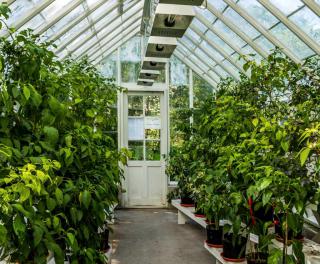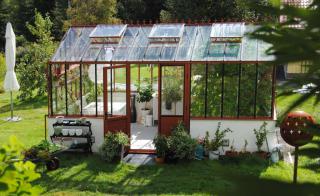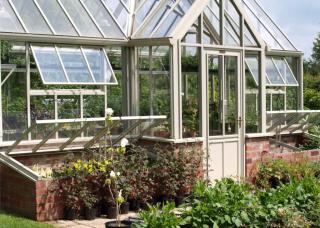

For those who are lucky to have a garden, perhaps you’re dreaming of one day being able to afford a garden greenhouse.
Of course, this is the dream of all plant-lovers in temperate climates.
If some greenhouses come out cheap at 200, 300 or 400 dollars, others can easily reach 5,000 dollars and more.
As for all major garden equipment, it makes sense to choose your greenhouse well before setting out to purchase it!
Ensure that you have enough space for your greenhouse, because many people actually buy greenhouses that are too big for the space they have available.
 The best exposure for a garden greenhouse is generally south, south-east and sheltered from strong winds.
The best exposure for a garden greenhouse is generally south, south-east and sheltered from strong winds.
In summer, if temperatures rise too much, it will always be possible to shade the inside with small curtains designed specifically for the purpose.
If possible, strive to avoid placing your greenhouse under trees because falling branches would fall and break the glass.
If a window pane breaks and a gust of wind blows into the greenhouse, the whole structure is at risk of flying apart. The main beams might fold.
These steps aren’t necessary, but they are highly recommended, as simple preparations are easier before the greenhouse is in place.
These preparations are related to connecting water and electricity for the greenhouse.
Some greenhouse manufacturers make it possible to anchor the greenhouse to the ground using concrete fixtures, this is highly recommended.
A greenhouse in itself isn’t very heavy, because the structure is made from aluminum and glass is relatively thin, around ⅛th of an inch (3 to 4 mm).
If you grow plants that tend to take up space, your greenhouse may quickly turn out to be too small.
For example, a lime tree (Persian Tahiti lime tree) only 2 feet (60 cm) tall in 2007 was over 8 feet tall and 6 ½ feet wide just 4 years later.
Some municipalities require building permits for greenhouses only when they exceed a given surface area, or are built as an extension of the house. In any case, it is rewarding to inquire at the local town hall or urban development office about this and put in the required paperwork.
Also take care to follow regulated buffer zones. In some places, construction of extensions or greenhouses is not possible at a certain distance both from your neighbors’ properties and from public land.
Ensure that the greenhouse has doors, preferably sliding doors, because a hinge door can slam with a gust of wind and break a pane of glass.
Choose a greenhouse type that allows for ventilation devices such as jalousies or dormer windows.
Some manufacturers offer different glass packages for the greenhouse windows. This can heavily influence the price of your greenhouse.
Horticultural glass is the standard fitting and is nothing more than common glass in a thickness of an ⅛th of an inch (3 to 4 mm).
This type of glass is also often available, and since it is toughened it is much more resistant than conventional horticultural glass.
It is said that this glass is 5 times stronger than standard horticultural glass.
Another type of pane can be used, and this is polycarbonate.
This is a sheet of plastic, with a thickness of around ⅝ths of an inch (1.5 cm), with a hollow core that makes it an excellent insulator.
This replaces the notion of hard pieces of sheet glass or plastic with flexible polythene plastic film instead. The structure must be self-supporting and the film is attached to it with special fixtures. Sometimes simple plastic tubing shaped into hoops nicely does the trick.
 Assembling a greenhouse is often akin to assembling a puzzle, and to avoid mistakes during assembly it is recommended to follow this advice:
Assembling a greenhouse is often akin to assembling a puzzle, and to avoid mistakes during assembly it is recommended to follow this advice:
If you choose to assemble your greenhouse yourself, take particular care in getting things level. If posts and frames aren’t level, it will be very difficult to fit the panes in.
Some greenhouse kits are assembled with stainless steel nuts and bolts. This of course provides for a greater strength, because steel can be tightened well and it will not rust.
Other kits are delivered with aluminum screws. Since aluminum is a ductile metal, it cannot be tightened as much, or the screws might break and strength will be compromised.
 Even though most greenhouses on the consumer market are designed with aluminum frames, recently more and more greenhouses are designed with wooden frames.
Even though most greenhouses on the consumer market are designed with aluminum frames, recently more and more greenhouses are designed with wooden frames.
Wood is heavier, and greenhouses made from wood have an advantage when it comes to resisting strong winds. However, anchoring the structure with concrete is still needed.
The wood used is chosen specifically to be weatherproof and is often treated so that it won’t deteriorate as time goes by.
Philordi